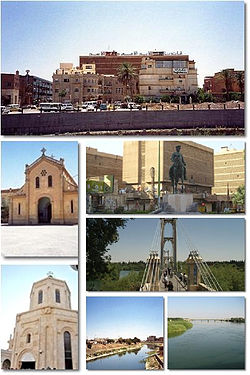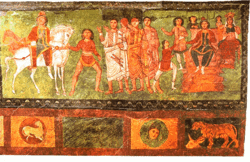Deir ez-Zor
Deir ez-Zor , also spelled Dayr al-Zawr, Der Ezzor, Deir Azzor, and other variants (Arabic: دير الزور; Syriac: [ܕܝܪܐ ܙܥܘܪܬܐ] Error: {{Lang}}: text has italic markup (help), Armenian: Տէր Զօր, Դեր Զոր, Ter Zor), is the 7th largest city in Syria and the largest in the eastern part of Syria. It is the capital of the Deir ez-Zor Governorate.[2] There were 211,857 people in 2004. It is on the shores of Euphrates River.
|
دير الزور Deir Ezzor, Deir Azzor | |
|---|---|
 | |
| Coordinates: 35°20′N 40°9′E / 35.333°N 40.150°ECoordinates: 35°20′N 40°9′E / 35.333°N 40.150°E | |
| Country | Syria |
| Governorate | Deir ez-Zor Governorate |
| District | Deir ez-Zor District |
| Government | |
| • Type | Governorate |
| Elevation | 210 m (690 ft) |
| Population (2004 census[1]) | |
| • City | 211,857 |
| • Metro | 239,196 |
| Time zone | UTC+2 (EET) |
| • Summer (DST) | UTC+3 (EET) |
The city is famous for the Deir ez-Zor suspension bridge across the Euphrates.[2] It was completed in 1927. The Deir ez-Zor Museum keeps thousands of items collected from nearby archeological sites in Northern Mesopotamia. Main campuses of Al-Furat University and Al-Jazeera University are also there.[3]
Deir Ez-Zor Media
From the discoveries of Dura-Europos to the southeast of Deir ez-Zor
The march of Khalid ibn al-Walid's army from Iraq to the Levant
The extent of the Ottoman Empire in 1566, upon the death of Suleiman the Magnificent
Ibrahim Pasha, the ruler of Syria (1831–1840)
King Faisal in 1920
References
- ↑ "Deir ez-Zor city population". Archived from the original on 2012-07-31. Retrieved 2012-07-14.
- ↑ 2.0 2.1 "Syrian Ministry of Tourism (in Arabic)". Archived from the original on 2020-04-27. Retrieved 2007-05-10.
- ↑ "Archived copy". Archived from the original on 2016-11-02. Retrieved 2012-07-14.
{{cite web}}: CS1 maint: archived copy as title (link)







